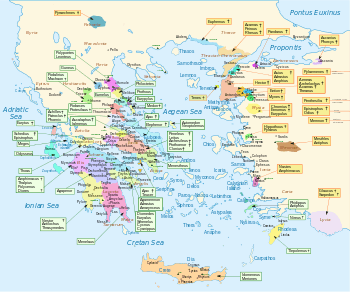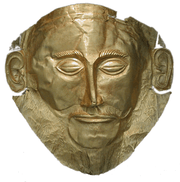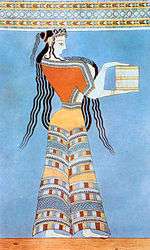Ancient History/Greece/Mycenaean Civilization
< Ancient History < Greece
The Mycenaean civilization refers to a Bronze Age civilization on mainland Greece, inhabiting the area from around 1600-1100 BCE. The name "Mycenaean" refers to the city of Mycenae, which was excavated by Heinrich Schliemann beginning in 1876. Schliemann is also well-known for discovering and excavating the city of Troy in Asia Minor, which was at the time believed to be fictional. Mycenaean Greece is the period in which the Iliad and Odyssey are set.
History
Mycenaean civilization originated and evolved from the society and culture of the Early and Middle Bronze Age in mainland Greece under influences from Minoan Crete.[1][2] These Bronze Age Greeks establish themselves as political units sometime around 1600. The Mycenaeans quite possibly lived under Minoan dominance until around 1400, when they conquered Crete.
Conflicts with Minoans
The Mycenaeans are often cited as one of the contributing factors to the rapid decline of Minoan civilization. The Minoans lived on the Aegean island of Crete, and had a naval influence that likely subjugated the Mycenaeans. Around the year 1600 BCE, it is believed that a volcanic eruption on the island of Santorini near Crete devastated the Minoans. The resulting weakness is thought to have allowed the Mycenaeans to overthrow the Minoans and replace them as the dominant culture of the region.
The Iliad

The Classical poet called Homer wrote the Iliad and Odyssey in the 8th or 7th century BCE, long after the Mycenaeans had vanished as a recognizable civilization. Because of this centuries-long gap in time, most scholars agree that Homer's epics cannot be viewed as accurate accounts of Mycenaean culture. It has been verified, however, that many of the places referred to in the Iliad and Odyssey were actual Mycenaean sites, including Troy.
Decline and collapse
Sometime around 1100, a tribe from the north known as the Dorians invaded the Peloponnesus and destroyed the Mycenaean civilization. Greece was subsequently thrown into a Dark Age, from which it took several centuries to recover. The written Mycenaean language was completely forgotten, forcing the Greeks to reinvent their writing system centuries later.
Culture
Religion
Not a great deal is known about the Mycenaean religion. It has been observed, however, that it was influenced to some degree by that of the Minoans. Many of the Mycenaean gods are recognizable to us as the well-known Classical gods, such as Zeus, Poseidon, Hera, Ares, Athena, Dionysus, and Hermes. Apollo, Aphrodite, and Hades are notable absences!
Art

Mycenaean artwork was influenced, like nearly all other aspects of their civilization, by the Minoans. Pottery, statues, and paintings make up the majority of Mycenaean art. Mycenaeans developed advanced bronze-working techniques, creating swords, shields, and suits of armor.
Architecture
In contrast to the Minoans, the Mycenaean leaders built fortresses — enormous walled structures that contained a megaron like the Minoan palace, but were primarily fortifications for defense. The walls of these structures often stood forty or fifty feet high, and were composed of enormous blocks of stone weighing two to three tons, fitted together without mortar. Fortresses at Tiryns and at Mycenae are considered the best examples of these military structures.
Unlike the Minoans, the Mycenaeans are not known to have built many religious shrines. A sacrificial site on Mount Lykaon sacred to Zeus in the Classical period has recently been found to pre-date Mycenaean occupation of the Greek peninsula or the Peloponnese, but no substantial structures of a religious nature have been identified at Mycenaean sites. Such buildings may have been incorporated into the palace-fortresses, but they are not specifically identified as such.
A Mycenaean common house has been located and identified. Dating from late in the Mycenaean period, it consists of a long, narrow building of posts with wattle-and-daub curtain walls and likely a thatched roof. One end of the house held an entry porch, while the opposite end was rounded and held the likely sleeping quarters. The interior was divided into two rooms, the aforementioned sleeping area farthest from the entrance, and a living area that contained a rudimentary hearth and a food-preparation area. The presence of sheep feces and wool fibers in the porch area suggest that the front entrance was used as a pen for holding animals.
Language
The language spoken by the Mycenaeans was an ancestor of modern Greek as shown on the Linear C tablet (the Minoan script from the Linear A tablet). Linear B was deciphered in the early 1950's, and proved to be an ancient form of the modern Greek language. This orthography resembled modern Japanese, in that it was syllabic instead of alphabetic. This form of writing, however, was forgotten during the Dark Ages, leading the Greeks of the classical era to develop a system of writing from a Egyptian model, allowing the alphabetic system to come into use.
Economy
A substantial number of Linear B texts, deal with matters of economic concern — inventories of possessions and lists of goods being brought to and from the palaces or sent out from the palaces. One of the most famous, used in the process of cracking Linear B as a language, lists provisions for the coast guard: apparently the so-called "Palace of Nestor" mounted a seaward watch on the approaches to its landfall, and paid the watchers in food and goods. These records suggest that the palaces were the principal economic engines of the era. They took in raw materials into workshops, where trained artisans produced finished goods, that would then be exchanged with other palaces for the best products of their local regions.
References
- ↑ Dickinson, Oliver (1977). The Origins of Mycenaean Civilization. Götenberg: Paul Aströms Förlag.
- ↑ Dickinson, Oliver (December 1999). Invasion, Migration and the Shaft Graves. Bulletin of the Institute of Classical Studies 43 (1). pp. 97–107. doi:10.1111/j.2041-5370.1999.tb00480.x.
| Ancient Greece Introduction ·
01. Minoans ·
02. Mycenaeans ·
03. Dark Ages |
|
Ancient Greece: Introduction · 01 · 02 · 03 · 04 · 05 |